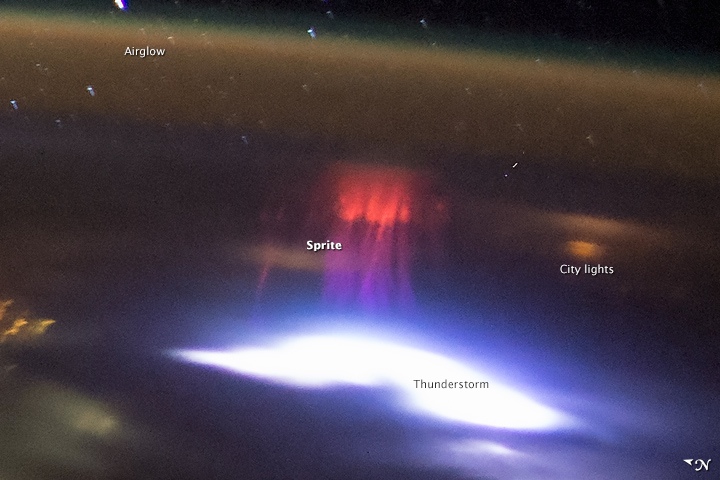Amazing 'Red Lightning' Photographed from Space

Like a giant jellyfish floating through the atmosphere, "red sprites" hover above thunderstorms in two new photographs snapped from space.
Astronauts aboard the International Space Station (ISS) captured two rare photographs of red sprites from above on Aug. 10. Red sprites are strange luminous phenomena that occur alongside more familiar lightning strikes. They're rarely seen from the ground because they occur above storms; they're also dim and hard to detect with the naked eye.
"They're very exciting to look at, they create these fabulous visual images, but there is a lot that we still don't understand about them," said Ryan Haaland, a professor of physics at Fort Lewis College in Colorado who is involved in an ongoing project studying sprites. [Images: Red Sprite Lightning Revealed in Stunning Photos]
Spritely images
The first sprite photograph shows the phenomenon somewhere over Missouri or Illinois, according to NASA's Earth Observatory, which published the images Aug. 24. The moon is visible as a bright spot in the night sky, and the city lights of Dallas light up the foreground of the photo. A thin green haze of airglow emanates from the atmosphere. The sprite appears above a white-blue thunderstorm.

A mere 2 minutes and 58 seconds later, the ISS whizzed over Acapulco, Mexico, and another red sprite appeared. This sprite flashed above a thunderstorm off the El Salvador coast. In both cases, the red sprites extended at least 62 miles (100 kilometers) above the Earth's surface, according to NASA's Earth Observatory. (The ISS orbits between 205 and 270 miles above the planet, or between 330 and 435 kilometers up.)
Like lightning, red sprites are caused by electrical discharges from storms, Haaland told Live Science. Sprites are usually produced by enormous summer thunderstorms known by meteorologists as mesoscale convective systems. They accompany traditional lightning, which primes the upper atmosphere for these colorful flashes, Haaland said.
Sign up for the Live Science daily newsletter now
Get the world’s most fascinating discoveries delivered straight to your inbox.
"Storms cause charges to get pushed around, and you get a charge imbalance," Haaland said. "That imbalance causes lightning and it also causes the sprites in the upper atmosphere."
Sprites aren't as hot as lightning, though, because the upper atmosphere is less dense than the lower atmosphere where lightning strikes.
"The only way to get high physical temperatures is to have lots of atoms, and we don't," Haaland said.
Atmospheric mystery
The blink-and-you'll-miss-them sprites remain largely mysterious, however. Scientists aren't sure what causes their tendril-like shapes, which can vary. Nor are they sure why some storms produce red sprites, while others produce different colorful upper-atmosphere phenomena, such as blue jets and dimly glowing ELVES (which stands, vaguely, for "Emissions of Light and Very Low Frequency Perturbations due to Electromagnetic Pulse Sources").
Sprites last a mere 20 milliseconds or so, Haaland said, and they're tough to measure. He and his colleagues at the University of Alaska at Fairbanks and the Air Force Academy take measurements from observatories in New Mexico and Wyoming that overlook the storm-prone Great Plains. But they've also had to fly expeditions using research aircraft operated by the National Center for Atmospheric Research (NCAR) in order to get closer. From afar, Haaland said, the optical signatures of red sprites are blurred by ambient light and atmospheric noise.
The goal, Haaland said, is to figure out both what causes red sprites and their kin, and if these phenomena perturb the upper atmosphere in any way.
"We really want to know what impact they have on the upper atmospheric electrodynamo and the upper atmospheric chemistry," he said. "Do they influence different chemical processes, or are they just something that happens?"
Follow Stephanie Pappas on Twitter and Google+. Follow us @livescience, Facebook & Google+. Original article on Live Science.

Stephanie Pappas is a contributing writer for Live Science, covering topics ranging from geoscience to archaeology to the human brain and behavior. She was previously a senior writer for Live Science but is now a freelancer based in Denver, Colorado, and regularly contributes to Scientific American and The Monitor, the monthly magazine of the American Psychological Association. Stephanie received a bachelor's degree in psychology from the University of South Carolina and a graduate certificate in science communication from the University of California, Santa Cruz.










